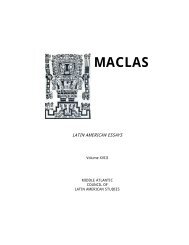latin american essays maclas
latin american essays maclas
latin american essays maclas
Create successful ePaper yourself
Turn your PDF publications into a flip-book with our unique Google optimized e-Paper software.
In the secret chambers of her computer she records family events,<br />
including an ugly fight between her parents over Estela’s impending visit,<br />
recorded in her “Family” file: “My parents have been fighting. The phrase whirled<br />
around her head for days until she saved it in a file called FAMILIA. They’ve been<br />
saying awful things to each other – she wrote. Things like coño and carajo,<br />
which are parts of the body, private parts, if you know what I mean;<br />
comemierda, shit-eater, and je m’en fou, which is Mom’s way of saying she<br />
doesn’t give a damn. Heavy stuff”(60). Gina’s recordings enable her to store, and<br />
then analyze the family drama that develops around her. She will, in due time,<br />
go back and work them into her “Brand New Memory.”<br />
The Tape Recorder<br />
Even though the tape recorder is not a particularly modern technological<br />
device, it is part of Gina’s armature of fact-finding and recording equipment. She<br />
is determined to find out why her mother, Elisa, has been so quiet and nice<br />
around Estela, whom she despises. Gina develops a strategy for taping their<br />
conversation. We see Gina’s need for firsthand information, as opposed to the<br />
indirect, or non-existent, information given by her parents. In this respect, Gina<br />
resembles many young Cuban Americans who do not trust their parents’<br />
generation to disclose the full reality of the Cuban exile experience:<br />
“Camerawoman had to get to the truth of it all somehow. La<br />
verité! She was in desperate need of data, craving firsthand<br />
information. So she decided to hide a voice-activated recorder inside a<br />
flower vase in the breakfast nook, and another in the den. If anything<br />
was going to happen, it would happen in one of those two places. . . .<br />
And it did. And thanks to the Moviemaker’s foresight, she managed to<br />
document the Turning Point! Her machine picked up the two Domingo<br />
ladies going at it! Transcribing and trans<strong>latin</strong>g the recording was no easy<br />
task, but the effort was well worth it.” (164)<br />
This passage is followed by the full dialogue between her mother and<br />
grandmother, as transcribed by Gina. All the recording devices are integrated<br />
into the plot structure as narrative devices that move the plot forward. They<br />
influence the movements of the characters, as well as the reader’s perception of<br />
those movements. They also give the novel a multiplicity of voices, putting the<br />
reader at the receptive center of a very intricate narrative line.<br />
The Narrative Voice and Technology<br />
The main narrator of this novel is crafted as a third person omniscient<br />
narrator who is totally in tune with Gina’s fourteen-year-old mind. Sometimes<br />
117




